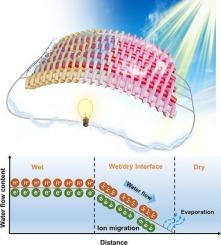一种可定制的非对称编织织物,用于从盐水中高效协同水电联产
IF 9.8
1区 工程技术
Q1 ENGINEERING, CHEMICAL
引用次数: 0
摘要
水和能源是人类文明不可或缺的支柱,但由于人口增长、气候变化、环境恶化,两者面临的挑战日益严峻。因此,提高水和能源系统的效率并减少其对环境的影响对于实现低碳、水安全的未来至关重要。本文介绍了一种新型的、可伸缩的、可调节的水电联产织物(PP-WECF)。PP-WECF集成了PEDOT:PSS纤维,可作为蒸发力驱动的电动发电机,亲水纤维可引导水,PANI纤维可实现太阳能驱动的蒸汽产生。PEDOT:PSS纤维和PANI纤维在PP-WECF中的整合有利于可持续运营和协同能源利用。此外,我们的研究结果表明,当太阳光照为1 kW·m−2时,PP-WECF在3.5 wt% NaCl溶液中表现出1.1 V、116.0 μA和1.6 kg·m−2·h−1的高效、自运行和可持续输出。白天可扩展的、长时间的、适应性强的户外操作确保了电力和淡水的清洁生产。本文章由计算机程序翻译,如有差异,请以英文原文为准。

A customizable woven asymmetric fabric for efficient synergistic water-electricity coproduction from saltwater
Water and energy are indispensable pillars of human civilization, yet both face mounting challenges due to population growth, climate change, and environmental degradation. Enhancing the efficiency of water and energy systems and reducing their environmental impact are thus critical to achieving a low-carbon, water-secure future. This study introduces a novel, scalable and adjustable water-electricity coproduction fabric (PP-WECF) developed via an accessible shuttle-flying weaving technique. The PP-WECF integrates PEDOT:PSS fibers, which serve as a transpiration-driven electrokinetic power generator, with hydrophilic fibers that channel water, and PANI fibers that enable solar-driven steam generation. The integration of PEDOT:PSS fibers and PANI fibers for PP-WECF facilitates sustainable operation and synergistic energy utilization. Furthermore, our results demonstrate that solar illumination of 1 kW·m−2, the PP-WECF shows an efficient, self-operating, and sustainable output of 1.1 V, 116.0 μA, and 1.6 kg·m−2·h−1 in 3.5 wt% NaCl solution. The scalable, prolonged, and adaptable outdoor operation throughout the daytime ensures the clean production of electricity and freshwater.
求助全文
通过发布文献求助,成功后即可免费获取论文全文。
去求助
来源期刊

Desalination
工程技术-工程:化工
CiteScore
14.60
自引率
20.20%
发文量
619
审稿时长
41 days
期刊介绍:
Desalination is a scholarly journal that focuses on the field of desalination materials, processes, and associated technologies. It encompasses a wide range of disciplines and aims to publish exceptional papers in this area.
The journal invites submissions that explicitly revolve around water desalting and its applications to various sources such as seawater, groundwater, and wastewater. It particularly encourages research on diverse desalination methods including thermal, membrane, sorption, and hybrid processes.
By providing a platform for innovative studies, Desalination aims to advance the understanding and development of desalination technologies, promoting sustainable solutions for water scarcity challenges.
 求助内容:
求助内容: 应助结果提醒方式:
应助结果提醒方式:


